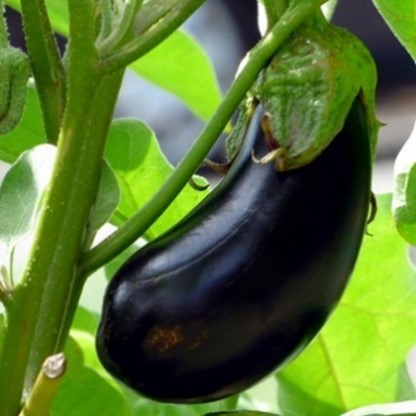by Rebecca Mendez, Bexar County Master Gardener
August 2023

(Photo:
AgriLife Learn-Texas A&M University)
The culinary garden at the San Antonio Botanical Garden (SABOT) is a good place to visit and discover varieties of herbs, vegetables, fruit trees, and other plants that perform well in San Antonio and the surrounding areas. As a SABOT docent volunteer, one plant has caught my attention—the eggplant—and my curiosity led me to find out more about this versatile and beautiful vegetable.
The eggplant originated in India and is a member of the nightshade family, which includes potatoes and tomatoes. In the past, the Spanish referred to the eggplant as the “apple of love,” while other Europeans labeled it the “mad apple.” Today we know it as a healthy vegetable and an excellent source of fiber and iron, potassium, and protein. Several varieties of eggplant exist including Fairy Tale, Black Beauty, Ichiban, and Clara Orient Express.
Location & Soil Preparation
To successfully grow eggplants in south Texas, choose a location that gets full sun and that has well-drained, nutrient-rich soil. To prepare the soil, remove all weeds and till the garden soil to a depth of 6 to 10 inches. Mix in a 3- to 4-inch layer of compost. Finally, add ½ tablespoon of 15-5-10 fertilizer into the soil for every ten feet of rows of seed or transplants. If you don’t have a lot of garden space, eggplants can successfully be grown in large containers.
Planting

(Photo: Skip Richter
Bryan College Station Eagle)
An advantage to growing eggplants here in south Texas is that they can be planted in both the spring and the fall. While eggplants can be started from seeds in the garden, heathy transplants are recommended. (If you want to plant seeds, you will need to sow them 6 to 8 weeks indoors before they are ready to transplant.)
Make sure that frost is no longer a threat and that daytime temperatures are 65 degrees and above. As you place the eggplant transplants in your garden, space them 24 to 36 inches apart. The eggplants grow from 2 to 4 feet tall. Add stakes or tomato cages for each eggplant since it may topple over when it is heavy with fruit. For a spring garden, eggplant transplants should be planted between March 15th and May 10th. For fall gardens, the transplants can be put in the garden between July 1st and July 25th. Eggplants are among the vegetables like okra, corn, and hot peppers that can tolerate summer temperatures.
Fertilizing
After transplanting, pouring ¼ cup of a starter solution around each transplant. To make a starter solution, mix 2 Tablespoons of the fertilizer into a gallon of water. As the eggplant grows, you will need to fertilize it every two to three weeks using a balanced, continuous-release fertilizer.
Watering
Eggplants will need a soaking of at least one inch of water each week. Of course, higher temperatures may increase the need for more water. If you notice droopy leaves, it is an indication that additional watering may be needed. You can also use the finger test, by pushing your forefinger into the soil next to each plant. If the soil is dry, water them. If the soil is moist, then extra water is not needed. If the soil feels soggy, you are watering too much. Mulching will help keep the soil moist and discourage weeds.
Harvesting

(Photo: Michelle Hobbs)
The time to harvest the eggplant depends on the variety. Most varieties take between 70 to 90 days to produce. When starting from seed, expect the time to be longer. To check for ripeness of the fruit, gently press the side of the plant with your thumbnail. If the mark from your thumbnail remains, then it should be ready to harvest. You can also tell by looking at its skin. When ready to harvest, the skin should appear glossy and dark (for purple varieties). To harvest, use pruning shears to cut off the fruit and leave an inch or two of stem on it.
Dull skin is a sign that the fruit is past its maturity. Leaving the fruit on too long will result in a change in its color, a bitter taste, and a very seedy fruit.
Storing & Eating Eggplants
Eggplants can be stored in the refrigerator for 2-3 weeks. There are many ways to prepare eggplant and numerous recipes are available on the internet.
One note of caution: Only the fruit should be consumed.
Helpful Resources:
https://aggie-hort.tamu.edu/archives/parsons/vegetables/eggplant.html
http://counties.agrilife.org/galveston/files/2012/03/Eggplant-Publ.-E-280.pdf

